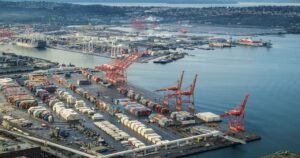The 2022 calendar year was a significant one for the maritime industry, particularly in China. PTI has thus taken on the responsibility of counting down the top 10 Chinese ports in 2022.
PTI is reviving its series that highlights the biggest and most effective ports from across the globe.
China’s maritime industry has had a very successful and busy year in 2022. The total container throughput of all Chinese ports was 295.9 million TEU for 2022. This reflected a 4.7 per cent increase from the throughput achieved in 2021.
The container handling data for the past year have given us a clear picture of which ports will be leading the way in 2023.
10. Port of Lianyungang
Near the mouth of the Qiangwei River in the Northern Jiangsu region of China, Lianyungang handled 5,570,000 TEU in 2022, representing a growth of 10.7 per cent year-on-year.
In July of 2022, Vostochnaya Stevedoring Company (VSC) launched SITC South Korea – China – Vietnam service and the Port of Lianyungang is one of the ports included on the service’s port rotation. This has heavily contributed to the port’s increased traffic.
9. Port of Rizhao
The Port of Rizhao experienced significant success in 2022 with a substantial increase in its cargo handling numbers. Container throughput at the deep-water seaport, on the coast of the city of Rizhao, increased by 12.1 per cent from 2021.
The Port of Rizhao handled a total of 5,800,000 TEU in 2022.
Rizhao Port, located in East China’s Shandong Province, has increased its container volumes by more than a fifth since the beginning of 2022. The volume of international freight trains had also skyrocketed, increasing by 81.5 per cent year-on-year. This ultimately contributed to their annual container volume increase.
8. Beibuwan Port
Beibuwan Port, also known as Beibu Gulf Port, is a seaport in the Guangxi province of China owned by the Guangxi Beibu Gulf International Port Group.
The port saw the biggest year-on-year growth of any port on this list in 2022, with a total throughput of 7,020,000 TEU.
This reflected an enormous 16.8 per cent increase from 2021.
Beibuwan also scored the biggest year-on-year rise on this ranking for the second consecutive year.
7. Port of Xiamen
The Port of Xiamen, situated along the Jiulongjiang River in southern Fujian, is a crucial deep-water port for the Chinese economy.
The port handled a total of 12,430,000 million TEU for the year, a throughput increase of 3.2 per cent from 2021.
This past year, COSCO SHIPPING introduced a new Wuhan-Xiamen sea-rail intermodal train with the inaugural trip having occurred on 26 June. This has significantly contributed to Xiamen’s increased throughput.
6. Port of Tianjin
The Port of Tianjin, the largest port in northern China, provides the principal marine entryway to the capital of China.
The port handled a total of 20,120,000 TEU in 2022, a 0.7 per cent increase from the previous year.
Tianjin is one of the spearheading ports for environmental reform and the decarbonation of the maritime industry.
Tianjin Port is now among the most technologically sophisticated facilities in the world thanks to Tianjin Port Group (TPG) and Huawei’s fully constructed new smart terminal earlier this year.
5. Port of Guangzhou
Guangzhou Port, which had previously ranked fourth on our ranking of China’s busiest ports, has now fallen to fifth place.
This Guangdong province port handled 24,600,000 TEU in 2022, reflecting a rise of 1.8 per cent from 2021, the joint second-smallest percentage annual growth of all the ports on this list. The shift in COVID-19 cases throughout the course of the year may have had a serious impact on Guangzhou’s industrial centre, thereby causing a decline in import and export shipping volume after the imposition of COVID-19 lockdowns.
4. Port of Qingdao
The Port of Qingdao moves up one rank from the previous year’s list to fourth, solidifying its place among China’s top five ports.
This significant port on the Yellow Sea handled 25,670,000 TEU in 2022, representing a rise of 8.3 per cent from 2021.
The Port of Qingdao is one of China’s fastest growing ports.
It has a number of cutting-edge technological initiatives aimed at boosting commerce and commercial transparency. A smart tech cluster is being developed at the Port of Qingdao by SITC International.
Additionally, Qingdao Port became the first 5G intelligent port and hydrogen-powered port in the world.
3. Port of Shenzhen
The Port of Shenzhen, which used to be the second busiest port in the nation, witnessed a 4.4 per cent growth from 2021 to handle 30,040,000 TEU.
Following a spike in COVID-19 cases in early 2022, shipping giant, Maersk, had closed its warehouse temporarily in Shenzhen while warehouse operations in Shanghai and Qingdao were still up and running.
This undoubtedly played a factor in the port letting up its position as the second busiest port in China.
2. Port of Ningbo-Zhoushan
Previously third place in 2020, the Port of Ningbo-Zhoushan remains the second-busiest port in China in 2022.
The port in the Zhejiang province handled a total of 33,350,000 TEU in 2022, representing a year-on-year increase of 7.3 per cent.
All Eastern provinces have upgraded their epidemic prevention and control efforts as a result of China experiencing its greatest rise in COVID-19 cases throughout 2022 since the pandemic started.
Despite the temporary shutdown of highway exits and service areas, the Port of Ningbo-Zhoushan is continuing to operate steadily.
1. Port of Shanghai
The Port of Shanghai, which continues to set the standard for China’s maritime sector, tops our list of Chinese ports once more.
Not only did the port surpass the Port of Singapore as the largest port in the world, but it now has a total of five operating zones.
The Port of Shanghai, which also topped PTI’s 2021 ranking, handled a staggering 47,300,000 TEU in 2022. This reflected a year-on-year increase of 0.6 per cent.
As the biggest container port in the world, the Port of Shanghai has started operations for an empty container transportation centre. According to government sources, the new centre, which can handle 3 million TEU annually, would increase the port’s capacity for handling cargo, foster domestic and international commerce, and consolidate Shanghai’s position as a hub for international shipping.













